The AMD Ryzen Threadripper 3960X and 3970X Review: 24 and 32 Cores on 7nm
by Dr. Ian Cutress, Andrei Frumusanu & Gavin Bonshor on November 25, 2019 9:05 AM ESTCPU Performance: Encoding Tests
With the rise of streaming, vlogs, and video content as a whole, encoding and transcoding tests are becoming ever more important. Not only are more home users and gamers needing to convert video files into something more manageable, for streaming or archival purposes, but the servers that manage the output also manage around data and log files with compression and decompression. Our encoding tasks are focused around these important scenarios, with input from the community for the best implementation of real-world testing.
All of our benchmark results can also be found in our benchmark engine, Bench.
Handbrake 1.1.0: Streaming and Archival Video Transcoding
A popular open source tool, Handbrake is the anything-to-anything video conversion software that a number of people use as a reference point. The danger is always on version numbers and optimization, for example the latest versions of the software can take advantage of AVX-512 and OpenCL to accelerate certain types of transcoding and algorithms. The version we use here is a pure CPU play, with common transcoding variations.
We have split Handbrake up into several tests, using a Logitech C920 1080p60 native webcam recording (essentially a streamer recording), and convert them into two types of streaming formats and one for archival. The output settings used are:
- 720p60 at 6000 kbps constant bit rate, fast setting, high profile
- 1080p60 at 3500 kbps constant bit rate, faster setting, main profile
- 1080p60 HEVC at 3500 kbps variable bit rate, fast setting, main profile
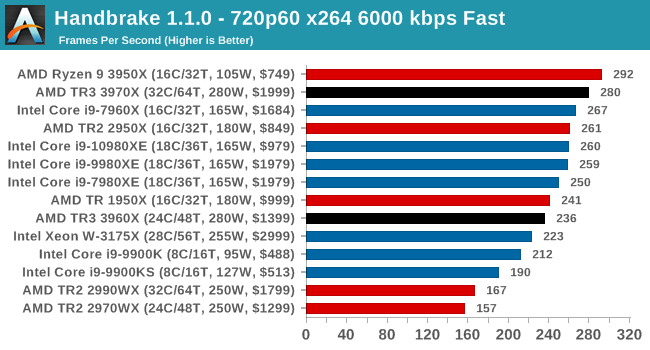
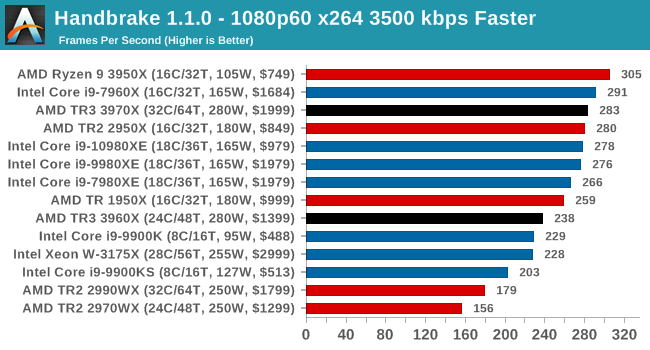

Video encoding is a little varied, based on the variable threaded nature. Certain encoding tests can be more memory sensitive here, or accelerated in different ways, or not scale well with more cores. Either way, TR3 performs a lot better than TR2, but the 3950X seems the best choice.
7-zip v1805: Popular Open-Source Encoding Engine
Out of our compression/decompression tool tests, 7-zip is the most requested and comes with a built-in benchmark. For our test suite, we’ve pulled the latest version of the software and we run the benchmark from the command line, reporting the compression, decompression, and a combined score.
It is noted in this benchmark that the latest multi-die processors have very bi-modal performance between compression and decompression, performing well in one and badly in the other. There are also discussions around how the Windows Scheduler is implementing every thread. As we get more results, it will be interesting to see how this plays out.
Please note, if you plan to share out the Compression graph, please include the Decompression one. Otherwise you’re only presenting half a picture.
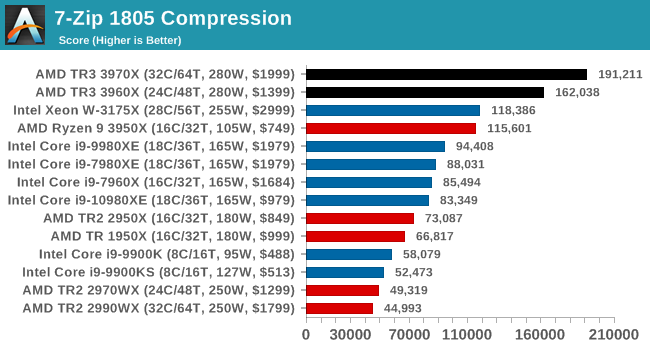
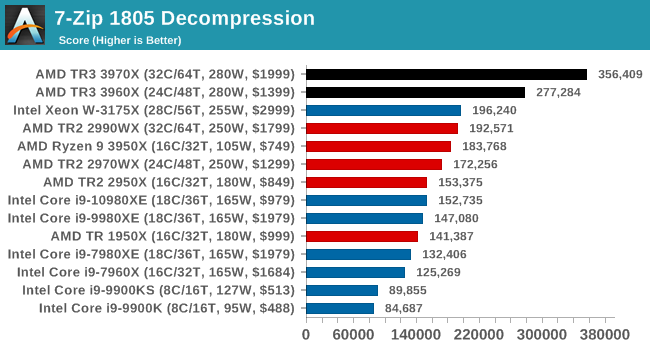
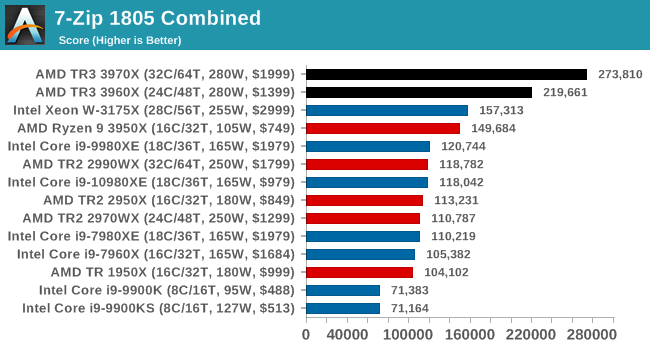
Easily parallel puts the TR3 well ahead of TR2 and Intel.
WinRAR 5.60b3: Archiving Tool
My compression tool of choice is often WinRAR, having been one of the first tools a number of my generation used over two decades ago. The interface has not changed much, although the integration with Windows right click commands is always a plus. It has no in-built test, so we run a compression over a set directory containing over thirty 60-second video files and 2000 small web-based files at a normal compression rate.
WinRAR is variable threaded but also susceptible to caching, so in our test we run it 10 times and take the average of the last five, leaving the test purely for raw CPU compute performance.
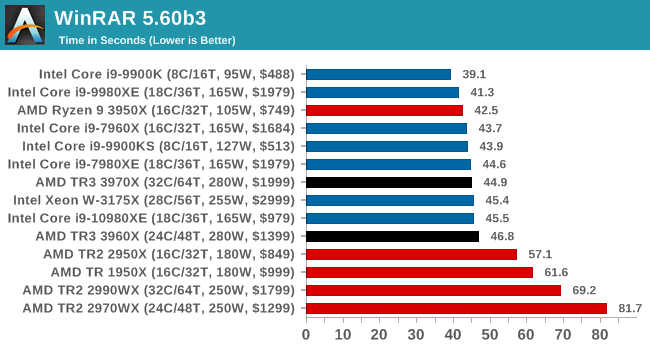
WinRAR is a variably threaded application, and both TR3 processors perform in the same ballpark as anything from Intel. Ideally we should have seen them streak ahead, but we seem to be at a point where CPU frequency or core counts are the limiting factor. At least with Zen 2, there are no issues as there was with Zen 1/Zen+.
AES Encryption: File Security
A number of platforms, particularly mobile devices, are now offering encryption by default with file systems in order to protect the contents. Windows based devices have these options as well, often applied by BitLocker or third-party software. In our AES encryption test, we used the discontinued TrueCrypt for its built-in benchmark, which tests several encryption algorithms directly in memory.
The data we take for this test is the combined AES encrypt/decrypt performance, measured in gigabytes per second. The software does use AES commands for processors that offer hardware selection, however not AVX-512.











245 Comments
View All Comments
schujj07 - Tuesday, November 26, 2019 - link
Where I work we now have 4x Dual 32 Core Epyc 7502s and 2x Dual 24 Core Epyc 7401s. We cannot move to Server 2016/2019 due to the per core licensing. However, for our VMware environment it is amazing how many VMs just 1 of those hosts can run.Supercell99 - Tuesday, November 26, 2019 - link
Is vmware stable on the new Epycs? I have some older Dells R630 2697 x2 I need to upgrade running ESXi 6.0 A bit nervous about jumping to AMD for production on vmware.schujj07 - Tuesday, November 26, 2019 - link
They are perfectly stable. We are running them for production work. 2nd Gen Epyc is only supported on 6.7 U3.Foeketijn - Tuesday, November 26, 2019 - link
On Epyc. Not TR. I would think.twtech - Monday, November 25, 2019 - link
Speaking of which, why does this review have so many gaming benchmarks, and say, no compiler benchmarks? I'd have liked to see the 32-core TR vs. the 3175x or 3275 compiling a large C++ project.eek2121 - Monday, November 25, 2019 - link
Not only that, but Anandtech is still doing gaming benchmarks on a Geforce 1080. Gamers Nexus has a much more production oriented review, but still no compiler benchmarks, etc.Slash3 - Tuesday, November 26, 2019 - link
I've never understood why AT has kept the GTX 1080. For purposes of benchmarking, it acts as an immediate bottleneck on faster CPUs and adds no value to a processor evaluation except in extreme cases such as the 2970WX/2990WX where performance impacts are made more readily evident. Even then, one or two simple tests would be enough to paint the picture, unless it called for further testing.It's simply a waste of benchmark time and continues to baffle me with its inclusion. The only reason I can think to keep it in reviews is to pad the Bench database, or that the tests can be completed quickly and it's simply spare time. I love AT, but sometimes they just make me scratch my head.
imaheadcase - Tuesday, November 26, 2019 - link
1080p is fine..they are using it for CPU benchmarks to bottleneck, not gpu.peevee - Tuesday, November 26, 2019 - link
It is GTX1080, not 1080p.DannyH246 - Monday, November 25, 2019 - link
Because Inteltech takes Intels $$$ and its one of the few areas where Intel doesn't get smashed.I agree with you, the main uses for these these kinds of CPU's are proper work not gaming. And definitely not gaming at 1080p. Its a joke.